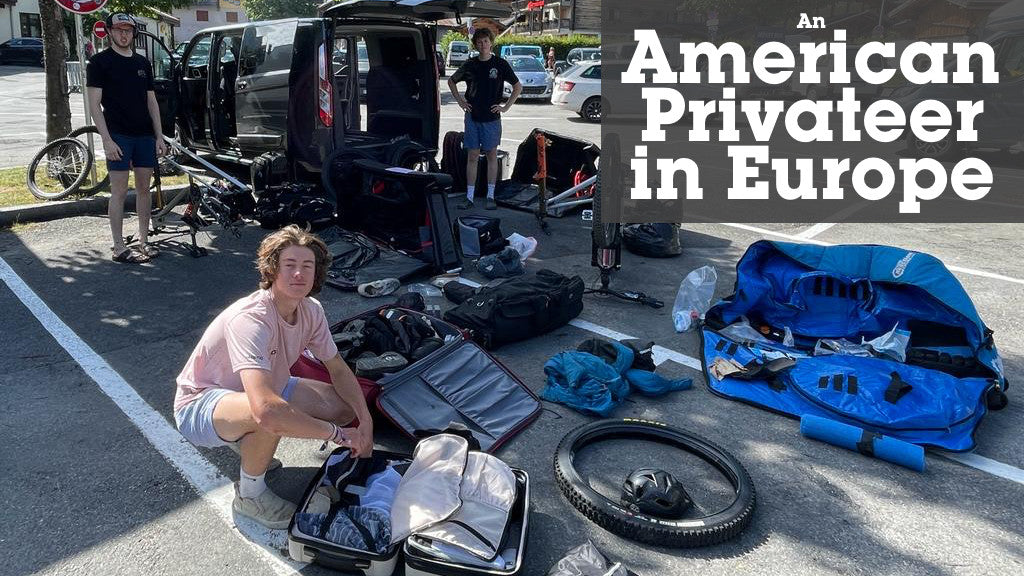Andrew Driscoll is a very fast 19-year-old, first-year elite from Bow, New Hampshire. Earlier this year, he set a plan in motion to travel to Europe and race some World Cups. His story is an interesting behind the scenes look at what it really takes to race at the highest levels as a privateer. Read more below...

My World Cup Adventure
by Andrew Driscoll
My name is Andrew Driscoll. Racing downhill mountain bikes at the highest level is extremely difficult for everyone competing—the logistics, mental and physical requirements, not to mention the fine line you have to push to even be competitive. Those difficulties and expenses multiply for racers who are funding the efforts on their own. Those like myself, racing independently and not part of a team that receives financial, logistical or staff support from a company, are considered non-factory riders or privateers. This past year, I spent four weeks in Europe competing at the Leogang World Cup, Crankworx Innsbruck, and Val Di Sole World Cup downhill races.

The goal of this article is to provide insight into what it takes to race European mountain bike downhill World Cups as a U.S.-based privateer—from preparation and packing to travel logistics and, of course, costs.
As background, I began riding mountain bikes when I was six and racing when I was twelve. I've always been fixated on racing due to my competitive nature and search for progress. That focus has taken me from local races to U.S. Nationals to racing World Cups as a Junior the past two seasons.
Thus far, my most notable finish has been 10th place at the 2022 World Championships in Let Gets, France. I've had some success, but not nearly enough to earn a spot on a factory-supported program.

Fortunately, I have some awesome sponsors (and parents) that help make everything possible. Some of which include RAAW Mountain Bikes, Reserve Wheels, Monster Army, Maxxis, DHaRCO, Factor Components, Burgtec, Crankbrothers, Oakley, FOX, and a local bike shop, The Notch Cyclery.
Despite all these companies' amazing support, there are logistical and financial roadblocks privateers face that factory riders don't. Don't get me wrong, every factory-supported rider has earned their spot, but the ratio is skewed when you compare the amount of extremely skilled bike riders to the number of factory spots available.

Most privateers live a 'normal' life outside of racing, and for me, that's being a traditional college student at the University of Vermont. The daily grind of college definitely takes time away from racing and training, but the long-term benefit of a college degree is obvious. I work part-time at Highland Mountain Bike Park throughout the season between races. Although this does not cover the cost of racing, working at Highland is a great job that allows me to stay on my bike.

Vermont has some amazing riding during the season but also a long winter, lasting from November to April. Due to an exceptionally rough winter and academic commitments, I focused mainly on gym time this off-season.
Ideally, I would have attended a few pre-season races to log some bike time and work on setup. However, I only made it to one pre-season race before leaving for Leogang: the Mountain Creek Spring National in late May. I surprised myself by qualifying 2nd and finishing 4th in my first official elite race. Looking back, that was a good confidence builder, but I would have preferred more racing and bike time before leaving for Europe.

Being a first-year Elite, I did not earn points to compete at a World Cup without a national jersey. Doing well at a World Cup is the best way to earn points. Other ways include competing in South American races in the off-season or a podium at a National round. The petition process may vary depending on a rider's federation/country. For U.S. racers, points are few, hard to come by, and certainly not easy to earn. As a result, I had to petition through USA Cycling to get a spot on the start list.
The tricky part is that the USA Cycling selection committee notifies you four to five weeks before an event. Once you're given the green light from USAC, it's full throttle confirming bookings and logistics reserved months prior. I spent the early winter months browsing online accommodation sites for cheap places to stay that also offered free cancellations. Finding an economical, nonstop, round-trip flight months before a departure is not easy. And as a privateer, it is key to fly nonstop to limit the chance of luggage and bikes getting lost.
There is a large presence of bike companies and vendors at World Cups, and there is always a chance they might offer mutual support if something really goes wrong, but being self-sufficient is crucial as a privateer. Preparing for the worst, aside from an extra frame and fork, I essentially brought an entire extra bike of spares with me—extra wheels, tires, shock, bars, brakes, brake pads, and not to mention tools and a pump.

Making room for a bike stand (something I don't think twice about having at races in the States) is virtually impossible to fit in luggage without going over weight limits. Preparing for what could go wrong with my bike means packing more luggage, which means more luggage fees, a larger rental car, and more money. Most times, a Sprinter or 8-passenger van is a necessity when traveling with this much luggage. In the end, I brought a bike bag, wheel bag, checked bag, carry-on, and backpack.

It is important to note I would not be able to do this without the help of my parents, both from a financial and logistical standpoint. As I mentioned above, I do work a summer job, but I don't make nearly enough money to cover the cost of racing at this level. Getting to experience all this at such a young age is amazing, but I truly could not do it myself for several reasons - my age and my credit line. I'm nineteen years old, and without my parents to rent the van, I would incur a 'young renter's fee,' which could add up to the cost of the rental. I have a credit card, but I do not have a high enough credit limit to allow me to book an airline ticket, a rental car, a few Airbnbs, and other expenses over the course of one month. Not to mention, most people my age don't qualify for a high-end credit card with travel benefits, including lost luggage reimbursement and rental car insurance. Adding car insurance to vehicle rental can, in some cases, doubles the cost of the rental itself.
Pre-Trip Costs
- Estimated days spent training in the offseason = 30 on-bike days // 100+ days in the gym or on the trainer
- College credits earned during the offseason = 28
- Estimated time spent booking travel = 10 hours
- Airline ticket (nonstop/round trip) = $1,930
- Shipping bike / Luggage fees = $450
- International drivers permit = $20
- UCI/USAC license = $290
- International Phone plan = $100
- Euros / spending cash = $208 (including the bank's transaction fee)
- Comprehensive Medical insurance plan = $120 (As a 19-year-old, I don't think much about insurance, but knowing the realities of downhill racing made finding a comprehensive travel insurance plan that covers medical and evacuation services essential. Most travel insurances exclude what they call 'high-risk sports', and mountain biking is usually on that list. If not, the fine print almost always includes exclusions related to "competitions" and/or 'racing.')
Additional Costs
- Rental Van = $2430
- Gas = $560
- Tolls = $200
- Laundry = $30
- Additional costs = $145 (including 2 days of Schladming lift tickets = $100 and sightseeing = $45)

